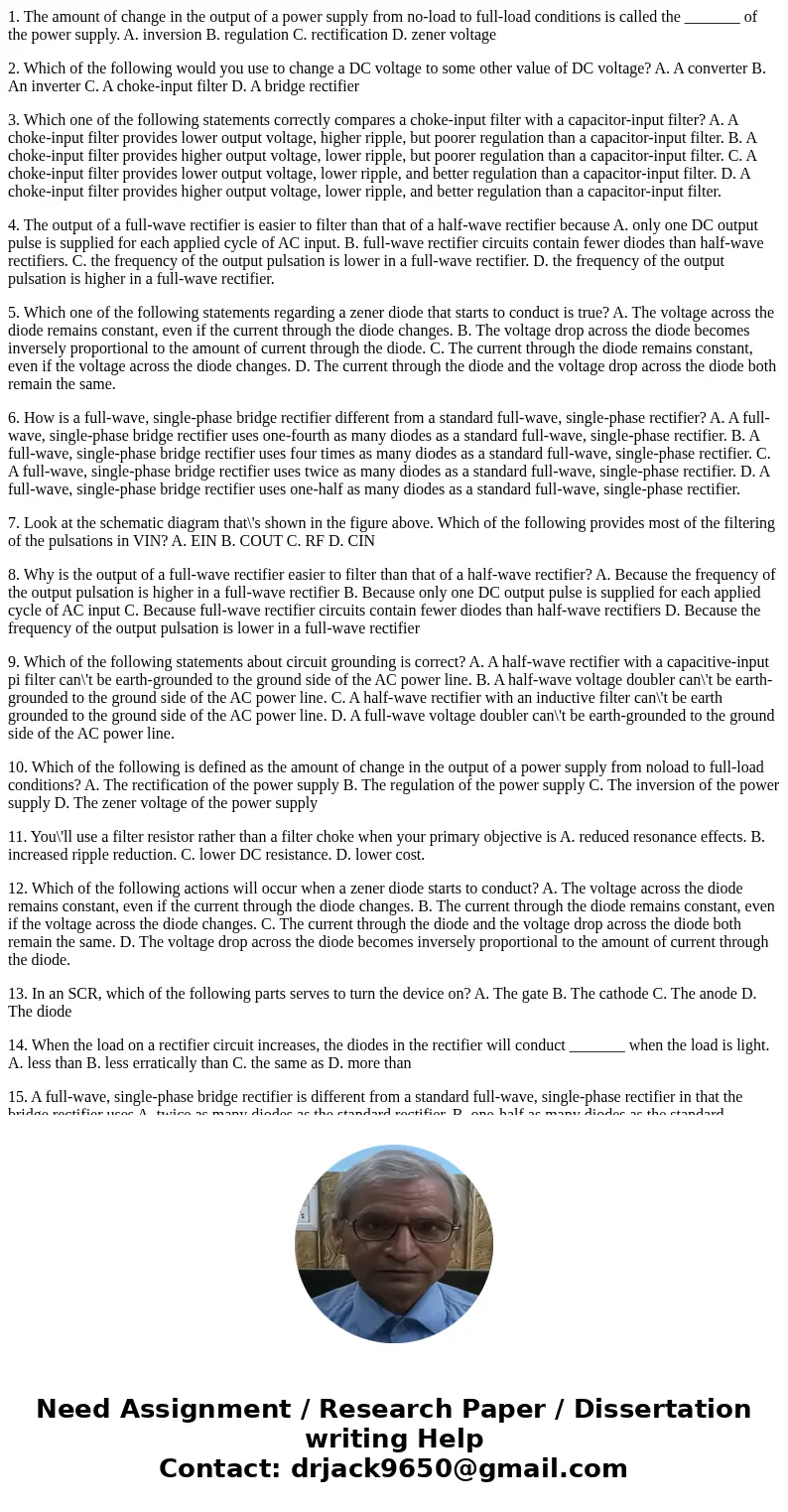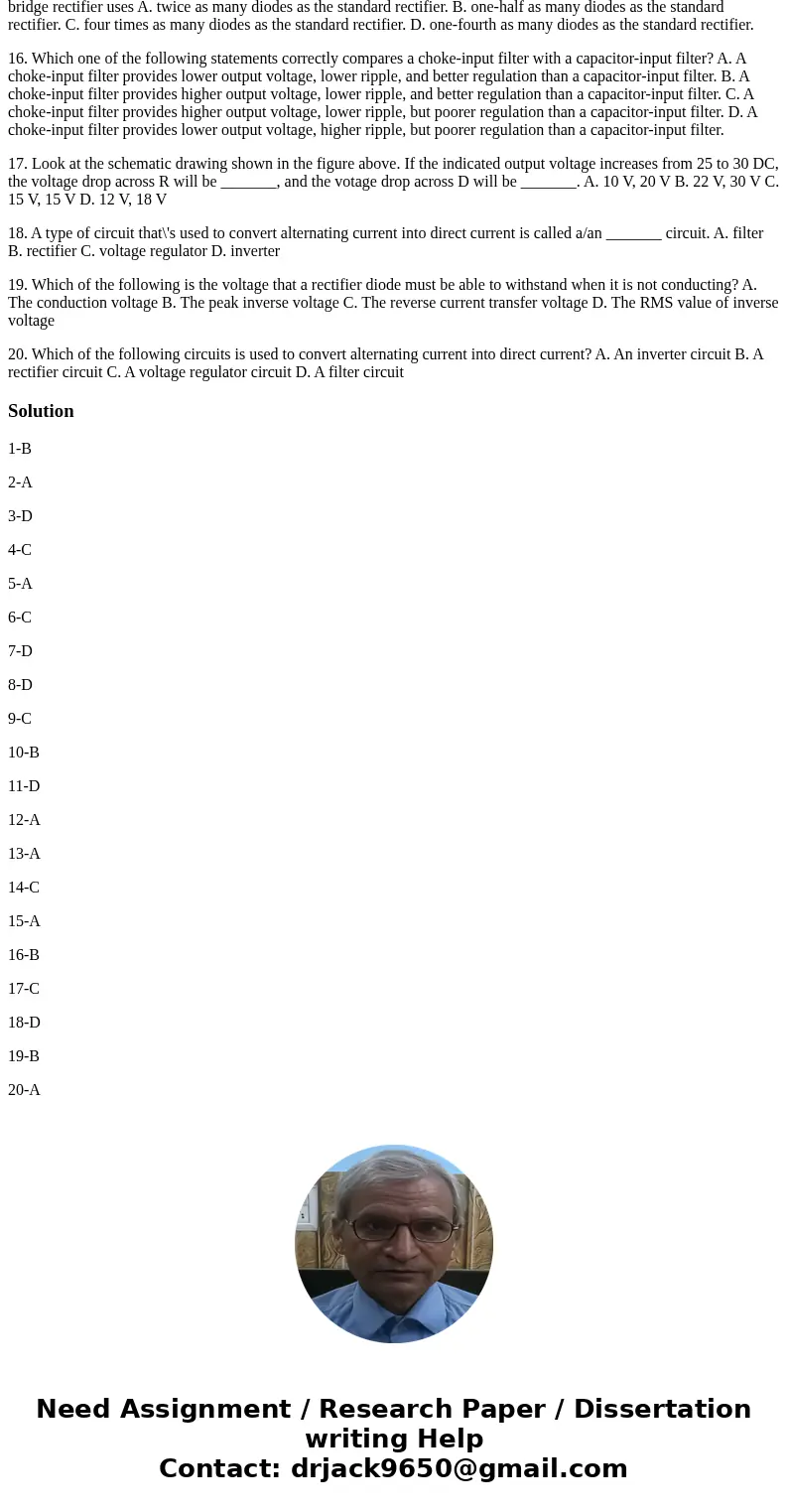1 The amount of change in the output of a power supply from
1. The amount of change in the output of a power supply from no-load to full-load conditions is called the _______ of the power supply. A. inversion B. regulation C. rectification D. zener voltage
2. Which of the following would you use to change a DC voltage to some other value of DC voltage? A. A converter B. An inverter C. A choke-input filter D. A bridge rectifier
3. Which one of the following statements correctly compares a choke-input filter with a capacitor-input filter? A. A choke-input filter provides lower output voltage, higher ripple, but poorer regulation than a capacitor-input filter. B. A choke-input filter provides higher output voltage, lower ripple, but poorer regulation than a capacitor-input filter. C. A choke-input filter provides lower output voltage, lower ripple, and better regulation than a capacitor-input filter. D. A choke-input filter provides higher output voltage, lower ripple, and better regulation than a capacitor-input filter.
4. The output of a full-wave rectifier is easier to filter than that of a half-wave rectifier because A. only one DC output pulse is supplied for each applied cycle of AC input. B. full-wave rectifier circuits contain fewer diodes than half-wave rectifiers. C. the frequency of the output pulsation is lower in a full-wave rectifier. D. the frequency of the output pulsation is higher in a full-wave rectifier.
5. Which one of the following statements regarding a zener diode that starts to conduct is true? A. The voltage across the diode remains constant, even if the current through the diode changes. B. The voltage drop across the diode becomes inversely proportional to the amount of current through the diode. C. The current through the diode remains constant, even if the voltage across the diode changes. D. The current through the diode and the voltage drop across the diode both remain the same.
6. How is a full-wave, single-phase bridge rectifier different from a standard full-wave, single-phase rectifier? A. A full-wave, single-phase bridge rectifier uses one-fourth as many diodes as a standard full-wave, single-phase rectifier. B. A full-wave, single-phase bridge rectifier uses four times as many diodes as a standard full-wave, single-phase rectifier. C. A full-wave, single-phase bridge rectifier uses twice as many diodes as a standard full-wave, single-phase rectifier. D. A full-wave, single-phase bridge rectifier uses one-half as many diodes as a standard full-wave, single-phase rectifier.
7. Look at the schematic diagram that\'s shown in the figure above. Which of the following provides most of the filtering of the pulsations in VIN? A. EIN B. COUT C. RF D. CIN
8. Why is the output of a full-wave rectifier easier to filter than that of a half-wave rectifier? A. Because the frequency of the output pulsation is higher in a full-wave rectifier B. Because only one DC output pulse is supplied for each applied cycle of AC input C. Because full-wave rectifier circuits contain fewer diodes than half-wave rectifiers D. Because the frequency of the output pulsation is lower in a full-wave rectifier
9. Which of the following statements about circuit grounding is correct? A. A half-wave rectifier with a capacitive-input pi filter can\'t be earth-grounded to the ground side of the AC power line. B. A half-wave voltage doubler can\'t be earth-grounded to the ground side of the AC power line. C. A half-wave rectifier with an inductive filter can\'t be earth grounded to the ground side of the AC power line. D. A full-wave voltage doubler can\'t be earth-grounded to the ground side of the AC power line.
10. Which of the following is defined as the amount of change in the output of a power supply from noload to full-load conditions? A. The rectification of the power supply B. The regulation of the power supply C. The inversion of the power supply D. The zener voltage of the power supply
11. You\'ll use a filter resistor rather than a filter choke when your primary objective is A. reduced resonance effects. B. increased ripple reduction. C. lower DC resistance. D. lower cost.
12. Which of the following actions will occur when a zener diode starts to conduct? A. The voltage across the diode remains constant, even if the current through the diode changes. B. The current through the diode remains constant, even if the voltage across the diode changes. C. The current through the diode and the voltage drop across the diode both remain the same. D. The voltage drop across the diode becomes inversely proportional to the amount of current through the diode.
13. In an SCR, which of the following parts serves to turn the device on? A. The gate B. The cathode C. The anode D. The diode
14. When the load on a rectifier circuit increases, the diodes in the rectifier will conduct _______ when the load is light. A. less than B. less erratically than C. the same as D. more than
15. A full-wave, single-phase bridge rectifier is different from a standard full-wave, single-phase rectifier in that the bridge rectifier uses A. twice as many diodes as the standard rectifier. B. one-half as many diodes as the standard rectifier. C. four times as many diodes as the standard rectifier. D. one-fourth as many diodes as the standard rectifier.
16. Which one of the following statements correctly compares a choke-input filter with a capacitor-input filter? A. A choke-input filter provides lower output voltage, lower ripple, and better regulation than a capacitor-input filter. B. A choke-input filter provides higher output voltage, lower ripple, and better regulation than a capacitor-input filter. C. A choke-input filter provides higher output voltage, lower ripple, but poorer regulation than a capacitor-input filter. D. A choke-input filter provides lower output voltage, higher ripple, but poorer regulation than a capacitor-input filter.
17. Look at the schematic drawing shown in the figure above. If the indicated output voltage increases from 25 to 30 DC, the voltage drop across R will be _______, and the votage drop across D will be _______. A. 10 V, 20 V B. 22 V, 30 V C. 15 V, 15 V D. 12 V, 18 V
18. A type of circuit that\'s used to convert alternating current into direct current is called a/an _______ circuit. A. filter B. rectifier C. voltage regulator D. inverter
19. Which of the following is the voltage that a rectifier diode must be able to withstand when it is not conducting? A. The conduction voltage B. The peak inverse voltage C. The reverse current transfer voltage D. The RMS value of inverse voltage
20. Which of the following circuits is used to convert alternating current into direct current? A. An inverter circuit B. A rectifier circuit C. A voltage regulator circuit D. A filter circuit
Solution
1-B
2-A
3-D
4-C
5-A
6-C
7-D
8-D
9-C
10-B
11-D
12-A
13-A
14-C
15-A
16-B
17-C
18-D
19-B
20-A


 Homework Sourse
Homework Sourse